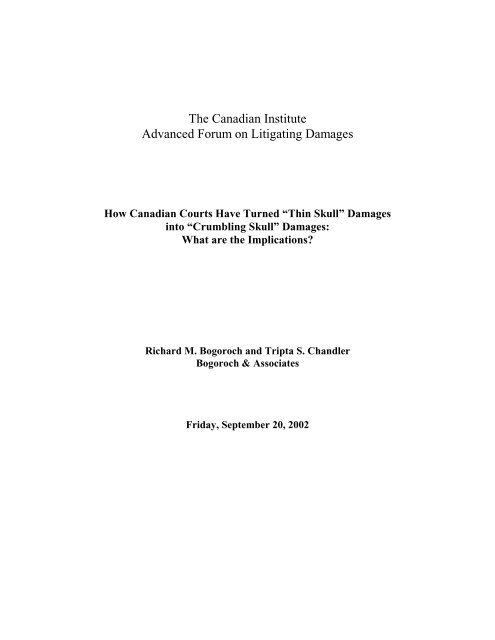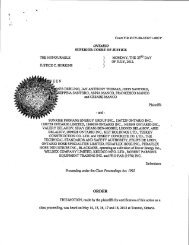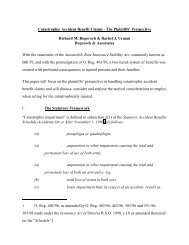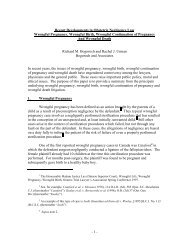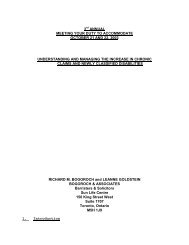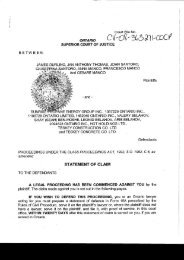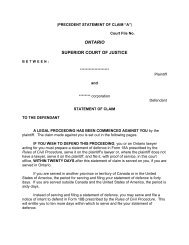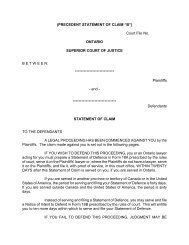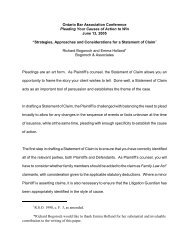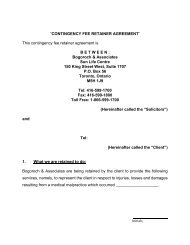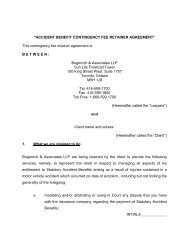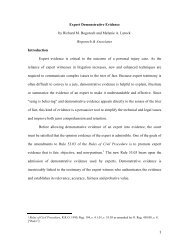"Thin Skull" Damages into "Crumbling Skull" Damages - Bogoroch ...
"Thin Skull" Damages into "Crumbling Skull" Damages - Bogoroch ...
"Thin Skull" Damages into "Crumbling Skull" Damages - Bogoroch ...
Create successful ePaper yourself
Turn your PDF publications into a flip-book with our unique Google optimized e-Paper software.
The Canadian Institute<br />
Advanced Forum on Litigating <strong>Damages</strong><br />
How Canadian Courts Have Turned “<strong>Thin</strong> Skull” <strong>Damages</strong><br />
<strong>into</strong> “<strong>Crumbling</strong> Skull” <strong>Damages</strong>:<br />
What are the Implications<br />
Richard M. <strong>Bogoroch</strong> and Tripta S. Chandler<br />
<strong>Bogoroch</strong> & Associates<br />
Friday, September 20, 2002
-2-<br />
How Canadian Courts Have Turned “<strong>Thin</strong> Skull” <strong>Damages</strong><br />
<strong>into</strong> “<strong>Crumbling</strong> Skull” <strong>Damages</strong>:<br />
What are the Implications<br />
TABLE OF CONTENTS<br />
PAGE<br />
1. Introduction 3<br />
II.<br />
The Supreme Court of Canada’s Decision in Athey v. Leonati<br />
A. History of the Action<br />
2. Causation<br />
3. <strong>Damages</strong><br />
4. Independent Intervening Events<br />
5. <strong>Thin</strong> and <strong>Crumbling</strong> Skull Plaintiffs<br />
III.<br />
Determination of Liability in the case of Tortious and Non-Tortious Factors<br />
Contributing to a Plaintiff’s Injury: The Implications of the Athey Decision<br />
A. Principles Enunciated in Athey<br />
2. Judicial Treatment of Athey<br />
(1) Alderson v. Callaghan<br />
(2) Dusk v. Malone<br />
(3) Brown v. Canadian Tire Corp.<br />
(4) Cottrelle v. Gerrard<br />
3. Summary of the Implications of Athey as Applied to Tortious and Non-Tortious Factors<br />
Contributing to a Plaintiff’s Injury
4. The Implications of the Ontario Court of Appeal’s decision in Robinson v. Sydenham<br />
Hospital: How the Court turned <strong>Thin</strong>-Skull <strong>Damages</strong> <strong>into</strong> <strong>Crumbling</strong> Skull Awards<br />
5. Athey v. Leonati: <strong>Damages</strong> Awarded to <strong>Thin</strong> Skull and <strong>Crumbling</strong> Skull Plaintiffs<br />
6. An Analysis of the Ontario Court of Appeal Decision in Robinson v. Sydenham District<br />
Hospital Corp.<br />
(1) History of the Action<br />
(2) The Court of Appeal Decision<br />
5. The Effect of the Alberta Court of Queen’s Bench Decision in Moser v. Derksen in<br />
Determining <strong>Damages</strong><br />
6. Conclusion
How Canadian Courts Have Turned “<strong>Thin</strong> Skull” <strong>Damages</strong><br />
<strong>into</strong> “<strong>Crumbling</strong> Skull” <strong>Damages</strong>:<br />
What are the Implications<br />
Richard M. <strong>Bogoroch</strong> and Tripta S. Chandler<br />
<strong>Bogoroch</strong> & Associates<br />
7. Introduction<br />
The Supreme Court of Canada’s ruling in Athey v. Leonati 1 is a definitive commentary on the<br />
manner in which liability and damages should be apportioned in tort actions. The Court discusses<br />
a myriad of possible scenarios in which tortious and non-tortious factors, pre-existing conditions and<br />
subsequent incidents may contribute to a plaintiff’s ultimate condition following a tortious act. The<br />
Court also addresses the difficult and often misunderstood issue of damage awards in cases involving<br />
thin skull and crumbling skull plaintiffs.<br />
This paper deals with the principles established in the Athey decision and their implications in the<br />
areas of causation and damages. The paper begins with a detailed analysis of the Athey case and then<br />
discusses the implications of the decision in determining liability in the case of tortious and nontortious<br />
factors contributing to a plaintiff’s injury, and the judicial treatment of the Athey decision<br />
in this context, with a particular focus on thin skull and crumbling skull plaintiffs. The final sections<br />
of the paper are a commentary on the courts’ assessment of damages in two recent decisions, the<br />
1 Athey v. Leonati, [1996] 3 S.C.R. 458 (QL) [hereinafter Athey].
-5-<br />
Ontario Court of Appeal’s decision in Robinson v. Sydenham District Hospital Corp. 2 and the<br />
Alberta Court of Queen’s Bench Decision in Moser v. Derksen 3 , and the difference between the<br />
approach taken in those cases and the principles established in Athey.<br />
8. The Supreme Court of Canada’s Decision in Athey v. Leonati<br />
A. History of the Action<br />
The Supreme Court of Canada’s 1996 decision in Athey v. Leonati provides a detailed analysis of<br />
the principles of causation and assessment of damages applicable to injuries involving thin skull and<br />
crumbling skull plaintiffs and pre-existing conditions.<br />
The plaintiff suffered back and neck injuries in two motor vehicle accidents in February and April,<br />
1991. The plaintiff had a history of back problems since 1972. Following the second accident, he<br />
2 Robinson v. Sydenham District Hospital Corp., [2000] O.J. No. 703 (Ont. C.A.) (QL)<br />
[hereinafter Robinson].<br />
3 Moser v. Derksen, [2002] A.J. No. 917 (Alta. Q.B.) (QL) [hereinafter Derksen].
-6-<br />
resumed his regular light exercise routine on the advice of his physician and suffered a herniated disc<br />
while stretching. The only issue at trial was whether the plaintiff’s disc herniation was caused by<br />
the injuries sustained in the accidents, or whether it was attributable to his pre-existing back<br />
problems. The trial judge held that, although the accidents were not the sole cause of the herniation,<br />
the plaintiff proved on a balance of probabilities that they contributed in some degree. The trial<br />
judge found that the accidents were responsible for 25% of the plaintiff’s injury and awarded the<br />
plaintiff 25% of the global damages assessed. The plaintiff’s appeal to the Court of Appeal was<br />
dismissed. At issue on the appeal to the Supreme Court of Canada was the whether the trial judge<br />
erred in apportioning causation (and therefore damages) between tortious and non-tortious causes.<br />
The Court held that, once the trial judge found that the plaintiff’s injuries in the motor vehicle<br />
accidents materially contributed to the disc herniation (i.e., that they contributed to the injury to the<br />
extent that they fell outside the de minimus range 4 ), the plaintiff had met the burden of proof and<br />
causation had been established. With respect to damages, the Court held that there could be no<br />
apportionment of damages between tortious and non-tortious contributing factors and therefore, the<br />
defendant would be fully liable for all damages flowing from the disc herniation. A detailed analysis<br />
of the Court’s reasoning follows.<br />
2. Causation<br />
Major J., speaking on behalf of a unanimous Court, enunciated several general principles of<br />
4 The Supreme Court of Canada held that the trial judge’s assessment that the accidents<br />
contributed to 25% of the plaintiff’s disc herniation fell outside the de minimus range.
-7-<br />
causation in tort law, as follows 5 :<br />
1. Causation is established where the plaintiff proves, on a balance of probabilities, that<br />
the defendant caused or contributed to the injury;<br />
2. The test for determining causation is the “but for” test, in which the plaintiff must<br />
establish that the injury would not have occurred but for the defendant’s negligence;<br />
3. In cases where the “but for” test is unworkable, courts have recognized that causation<br />
is established where the defendant’s negligence “materially contributed” to the<br />
occurrence of the injury. As stated above, a materially contributing factor is one that<br />
falls outside the de minimus range; and<br />
4. The plaintiff need not prove that the tortious act was the sole cause of the injury. As<br />
long as the tortious act is part of the cause, the defendant is liable, even if the tortious<br />
act alone was not sufficient to cause the injury.<br />
This analysis sets the stage for the Court’s discussion of damages and the principles to be applied<br />
when dealing with thin skull and crumbling skull plaintiffs.<br />
3. <strong>Damages</strong><br />
Once causation is established, the Court deals with the issue of damages where there is more than<br />
5 Athey, supra note 1 at 5-6.
one factor contributing to a plaintiff’s injury. As a general principle, the Court states that<br />
-8-<br />
(t)he essential purpose and most basic principle of tort law is that the plaintiff must<br />
be placed in the position he or she would have been in absent the defendant’s<br />
negligence (the ‘original position’). However, the plaintiff is not to be placed in a<br />
position better than his original one. It is therefore necessary not only to determine<br />
the plaintiff’s position after the tort but also to assess what the ‘original position’<br />
would have been. It is the difference between these positions, the ‘original position’<br />
and the ‘injured position’, which is the plaintiff’s loss 6 .<br />
6 Ibid. at 8.
-9-<br />
With respect to the presence of other, non-tortious, factors contributing to the plaintiff’s injuries, as<br />
in the case at bar, the Court applies the principle of full compensation and the need to return the<br />
plaintiff to his original position, stating that “a defendant is liable for any injuries caused or<br />
contributed to by his or her negligence. If the defendant’s conduct is found to be a cause of the<br />
injury, the presence of other non-tortious contributing causes does not reduce the extent of the<br />
defendant’s liability” 7 . The Court further states that “(t)here is no basis for a reduction of liability<br />
because of the existence of other preconditions: defendants remain liable for all injuries caused or<br />
contributed to by their negligence” 8 .<br />
Major J. states that courts should not apportion liability for injuries caused by tortious and nontortious<br />
causes, which would result in the plaintiff not being fully compensated, since he would not<br />
be placed in the position he would have been in absent the defendant’s negligence.<br />
4. Independent Intervening Events<br />
In assessing damages where an unrelated event, such as a disease or non-tortious accident, occurs<br />
after the plaintiff is injured, the Court states that “(t)he plaintiff’s loss is the difference between the<br />
original position the plaintiff would have been in absent the defendant’s negligence and the<br />
plaintiff’s position after the tort. Where an intervening event unrelated to the tort affects the<br />
plaintiff’s ‘original position’, the net loss is not as great as it might have otherwise seemed, so<br />
7 Ibid. at 5.<br />
8 Ibid. at 6.
-10-<br />
damages would be reduced to reflect this”. 9<br />
An independent intervening event will affect the<br />
plaintiff’s original position and therefore reduce the plaintiff’s net loss.<br />
5. <strong>Thin</strong> and <strong>Crumbling</strong> Skull Plaintiffs<br />
9 Ibid. at 8.
-11-<br />
The Supreme Court of Canada discussed the thin skull and crumbling skull rules at length. A thin<br />
skull plaintiff is one who has a latent, pre-existing condition or vulnerability to injury which is<br />
brought out by a tortious act but which would not otherwise have exhibited itself. The Court states<br />
that the thin skull rule “makes the tortfeasor liable for the plaintiff’s injuries even if the injuries are<br />
unexpectedly severe owing to a pre-existing condition. The tortfeasor must take his or her victim<br />
as the tortfeasor finds the victim, and is therefore liable even though the plaintiff’s losses are more<br />
dramatic than they would be for the average person.” 10<br />
The thin skull rule applies to make the<br />
defendant fully liable for all of the damages flowing from the tortious act, notwithstanding that the<br />
consequences of the tortious act are greater than they would have been had the plaintiff not suffered<br />
from a thin skull.<br />
In contrast, Major J. states that the crumbling skull rule<br />
simply recognizes that the pre-existing condition was inherent in the plaintiff’s<br />
‘original position’. The defendant need not put the plaintiff in a position better than<br />
his or her original position. The defendant is liable for the injuries caused, even if<br />
they are extreme, but need not compensate the plaintiff for any debilitating effects of<br />
the pre-existing condition which the plaintiff would have experienced anyway. The<br />
defendant is liable for the additional damage but not the pre-existing damage 11 .<br />
The crumbling skull rule applies to a plaintiff whose “injured position”is a result of both the tortious<br />
10 Ibid. at 9.<br />
11 Ibid.
-12-<br />
act and the plaintiff’s pre-existing condition.<br />
Major J.’s analysis indicates that a plaintiff’s injuries resulting from a tortious act must be separated<br />
from those injuries or disabilities not resulting from the tortious act, and the defendant is held liable<br />
only for damage resulting from the tortious act. In this regard, Major J. states that<br />
if there is a measurable risk that the pre-existing condition would have detrimentally<br />
affected the plaintiff in the future, regardless of the defendant’s negligence, then this<br />
can be taken <strong>into</strong> account in reducing the overall award....This is consistent with the<br />
general rule that the plaintiff must be returned to the position he would have been in,<br />
with all of its attendant risks and shortcomings, and not a better position 12 .<br />
The Supreme Court of Canada holds that the plaintiff in Athey was neither a thin skull nor a<br />
crumbling skull plaintiff and therefore, according to the principles enunciated by the Court and<br />
applicable to cases involving tortious and non-tortious contributing factors, and on the application<br />
of the “material contribution” test, the defendant was fully liable for the plaintiff’s disc herniation.<br />
III.<br />
Determination of Liability in the case of Tortious and Non-Tortious Factors<br />
Contributing to a Plaintiff’s Injury: The Implications of the Athey Decision<br />
A. Principles Enunciated in Athey<br />
The Athey decision established a set of three general rules to be applied to the determination of<br />
12 Ibid.
-13-<br />
causation when determining whether a plaintiff has established that a tortious act materially
-14-<br />
contributed to his injury, in a case where there may be tortious and non-tortious contributing<br />
factors 13 :<br />
2. if the plaintiff’s injury would likely have occurred at the same time without the<br />
injuries sustained as a result of the tortious act, causation is not proven;<br />
3. if both the tortious and non-tortious acts were necessary to the injury, causation is<br />
proven, since the injury would not have occurred but for the tortious act. Even if the<br />
tortious act played a minor role, the defendant would be fully liable because the<br />
tortious act was still a necessary contributing cause; and<br />
4. if the tortious act alone could have been a sufficient cause, and similarly, the nontortious<br />
act could have been a sufficient cause of the injury, the trial judge must<br />
determine, on a balance of probabilities, whether the tortious act materially<br />
contributed to the injury.<br />
Athey has been cited in a number of Ontario decisions since 1996. Ontario courts have generally<br />
not engaged in an in-depth analysis of the decision itself but have, with a few exceptions discussed<br />
below, consistently applied the principles enunciated by the Supreme Court of Canada regarding<br />
multiple contributing factors to accidents, both tortious and non-tortious.<br />
13 Ibid. at 10.
-15-<br />
2. Judicial Treatment of Athey<br />
(1) Alderson v. Callaghan 14<br />
In Alderson v. Callaghan, the Ontario Court of Appeal considered a trial judge’s instruction to the<br />
jury with respect to causation and the assessment of damages. The plaintiff was a passenger in a<br />
vehicle operated by the defendant, who admitted liability for the accident. The plaintiff claimed<br />
damages for a serious brain injury and related memory problems, personality changes and mental<br />
impairment. The defendant claimed that these injures were not related to the accident, but were the<br />
result of two factors: beatings inflicted on the plaintiff by the defendant and a non-party following<br />
the accident and the plaintiff’s pre-accident psychological and emotional problems. With respect<br />
to the assessment of damages, the trial judge instructed the jury to consider the plaintiff’s overall<br />
condition and then determine which portion of her “injured position” was attributable to the<br />
accident.<br />
In a decision authored by Moldaver J., the Court of Appeal ordered a new trial on the basis that the<br />
trial judge had misdirected the jury on the issue of causation.<br />
Anderson].<br />
14 Anderson v. Callaghan (1988), 40 O.R. (3d) 136 (Ont. C.A.) (QL) [hereinafter
-16-<br />
With respect to the subsequent tortious acts, Moldaver J. states that, based on Athey, the fact that<br />
the plaintiff’s overall condition may have been exacerbated by the post-accident assaults does not<br />
relieve the defendant from full responsibility 15 . This is consistent with general legal principles<br />
allowing joint tortfeasors to seek contribution and indemnity from one another 16 . As such, there is<br />
no justification for reducing the damages awarded on the basis that there have been subsequent<br />
tortious events. This approach is also consistent with the Supreme Court of Canada’s statement that<br />
the plaintiff must be placed in the position which she would have been in had the tortious incident<br />
not occurred.<br />
Moldaver J. states that, in light of the Athey decision, the jury should have been advised that, if the<br />
plaintiff’s overall condition resulted from the cumulative effect of the injuries sustained in the<br />
accident, the post-accident beatings and her pre-existing psychological problems, she would<br />
nonetheless be entitled to full compensation if the jury was satisfied, on a balance of probabilities,<br />
that the injuries sustained in the accident materially contributed to her overall condition (this would<br />
be an award of thin skull damages, combined with the principle that joint tortfeasors may claim<br />
15 Ibid. at 3.<br />
16 Ibid.
contribution and indemnity from one another).<br />
-17-<br />
Moldaver J. further states that, if the jury was not satisfied that the injuries sustained in the accident<br />
materially contributed to the plaintiff’s overall condition, they should have been instructed to assess<br />
the plaintiff’s damages based on the nature and extent of those injuries which could be directly<br />
attributed to the accident (this would be an award of crumbling skull damages, again combined with<br />
the principles applicable to joint tortfeasors) 17 . Although Moldaver J. does not make a<br />
determination as to whether the plaintiff suffered from a thin skull or a crumbling skull, his<br />
judgment indicates that, once the determination is made, the jury should be instructed in accordance<br />
with the principles regarding damages enunciated in Athey.<br />
(2) Dusk v. Malone 18<br />
In Dusk v. Malone, Brennan J. of the Ontario Superior Court of Justice also applied Athey. The<br />
plaintiffs, Dusk and Mackie, claimed damages for injuries sustained in a 1989 motor vehicle<br />
accident. The plaintiff, Dusk, sustained injuries to his neck and back. He had a history of lifelong<br />
spinal difficulties, including scoliosis and degenerative disc disease and had sustained a spinal injury<br />
in a 1972 motor vehicle accident. The plaintiff had received periodic chiropractic treatments from<br />
childhood to 1987.<br />
Brennan J. accepted the evidence of the plaintiff’s expert that, in the absence of the motor vehicle<br />
17 Ibid.<br />
18 Dusk v. Malone, [1999] O.J. No. 3917 (Ont. S.C.J.) (QL) [hereinafter Dusk].
-18-<br />
accident, the plaintiff’s symptoms would not have occurred. Brennan J. concluded that, given his<br />
pre-existing condition, the plaintiff was more vulnerable to back injuries than an ordinary victim.<br />
Brennan J. therefore applied the Athey principles with respect to thin skull plaintiffs and held that,<br />
in light of the fact that the defendant had not proved on a balance of probabilities that the plaintiff<br />
would have reached the same condition based solely on his pre-existing problems, the defendant was<br />
liable for all losses flowing from the plaintiff’s injuries 19 .<br />
19 Ibid. at 4-5.
-19-<br />
(3) Brown v. Canadian Tire Corp. 20<br />
In Brown, the Ontario Superior Court of Justice deals with an action for damages brought by a<br />
plaintiff for shoulder injuries resulting from injuries sustained while using a defective<br />
sledgehammer. The plaintiff had a long history of shoulder dislocations and had been advised to<br />
undergo surgery. However, in the two years preceding the incident, he experienced no shoulder<br />
problems. Following the incident, the plaintiff’s shoulder problems worsened and he experienced<br />
further dislocations and functional limitations. The issue at trial was whether the accident caused<br />
the plaintiff’s complaints, or whether his complaints were caused by his pre-existing shoulder<br />
condition, as a result of which he would have suffered the same disability, even if the accident had<br />
not occurred.<br />
Brown].<br />
20 Brown v. Canadian Tire Corp., [2000] O.J. No. 4722 (Ont. S.C.J.) (QL) [hereinafter
-20-<br />
Spence J. concludes that it was inevitable that the plaintiff would have suffered the same problems<br />
had the accident not occurred, but the accident likely accelerated the onset of the symptoms so<br />
causation cannot be ruled out 21 . Spence J. states that, in light of his finding that either the tortious<br />
act or the non-tortious factors could have been the cause of the plaintiff’s injury, the third principle<br />
of causation, as enunciated in Athey 22 , applies. Therefore, the Court must determine, on a balance<br />
of probabilities, whether the tortious act materially contributed to the injury. Spence J. concludes<br />
that the accident materially contributed to the plaintiff’s injuries 23 and accordingly, held the<br />
defendants liable for the full extent of the plaintiff’s losses.<br />
(4) Cottrelle v. Gerrard 24<br />
The Cottrelle case is another example of the straightforward application of the Athey principles<br />
regarding multiple contributing factors by Leitch J. of the Ontario Superior Court of Justice. The<br />
plaintiff in Cottrelle was a diabetic with a history of smoking and high blood sugar levels, both<br />
which put her at increased risk of developing vascular disease leading to the development of<br />
gangrenous tissue in her feet which could require amputation. In 1993, the plaintiff developed a sore<br />
on her foot which subsequently developed <strong>into</strong> a deeper infection and which contributed to the<br />
development of gangrene and the resulting amputation of the plaintiff’s leg below the knee.<br />
21 Ibid. at 6.<br />
22 See Part II(B), above, for a discussion of this principle.<br />
23 Brown, supra note 20 at 7.<br />
24 Cottrelle v. Gerrard, [2001] O.J. No. 5472 (Ont. S.C.J.) (QL) [hereinafter Cottrelle].
-21-<br />
The medical evidence at trial indicated that the need to amputate the plaintiff’s leg resulted from a<br />
combination of the (pre-existing, undiagnosed and latent) vascular disease arising from her diabetes<br />
and the infection of the sore on her foot. The medical evidence also suggested that, had the<br />
plaintiff’s sore been properly treated in a timely fashion, she may not have developed gangrene and<br />
the amputation of her leg may not have been necessary. There was conflicting medical evidence that<br />
indicated that the plaintiff would have required an amputation as a result of her vascular disease at<br />
some point in any event and also that, even if the sore had been properly treated, given the advanced<br />
stage of her vascular disease, amputation was inevitable.<br />
In dealing with the issue of causation, Leitch, J. finds that the plaintiff’s sore was not properly<br />
treated by the defendant family physician and this breach of the standard of care resulted in the<br />
development of deeper infection, which in turn contributed to the development of gangrene and the<br />
resulting need for amputation. Leitch J. considers the Athey principles applicable to injuries caused<br />
by pre-existing conditions and tortious factors. Specifically, Leitch J. states that the plaintiff need<br />
not establish that the negligence was the sole cause of her injury and a defendant is not excused from<br />
liability merely because other causal factors for which he is not responsible helped produce the<br />
harm 25 .<br />
In assessing the plaintiff’s damages, Leitch, J. considers whether there should be a reduction in the<br />
damages awarded based on the plaintiff’s pre-existing vascular disease; specifically, whether, as<br />
stated in Athey, there was a measurable risk that this condition would have detrimentally affected<br />
her in the future, notwithstanding the defendant’s negligence. Leitch J. applies the Athey doctrine
-22-<br />
applicable to crumbling skull plaintiffs: the defendant need not return the plaintiff to a better<br />
“original position” than she would otherwise have been in. In considering the evidence of the<br />
medical experts regarding the “measurable risk” that the plaintiff would have required an amputation<br />
as a result of her vascular disease notwithstanding the defendant’s negligence, Leitch J. reduces the<br />
damages awarded by 15% 26 .<br />
25 Ibid. at 13.<br />
26 Ibid. at 23.
-23-<br />
4. Summary of the Implications of Athey as Applied to Tortious and Non-Tortious Factors<br />
Contributing to a Plaintiff’s Injury<br />
The Athey decision has encouraged courts to consider cases in which a plaintiff suffers injuries<br />
caused by a combination of tortious and non-tortious factors (or pre-existing conditions) by using<br />
a two-step process based on long-standing tort principles. The first step deals with the issue of<br />
causation and involves a determination as to whether the tortious factor at issue in the action<br />
materially contributed to the plaintiff’s injury. Inherent in this analysis is the consideration of<br />
whether the plaintiff would have suffered the same problems at the same time had the tortious event<br />
not occurred, as in the Brown, Dusk and Cottrelle cases, and whether there is a measurable risk that<br />
the pre-existing condition would have caused the plaintiff’s condition to deteriorate in the future,<br />
even without the tortious act.<br />
The second step deals with the issue of damages. The fundamental principle established in Athey and<br />
followed by Ontario courts is that the plaintiff must be returned to her original position, but not a<br />
better position, than she would have been in had the tortious act not occurred. Once causation is<br />
proven, a defendant is held liable for the full extent of the plaintiff’s damages arising from the<br />
tortious act. The only variation of this principle occurs when, as in the Cottrelle case, there is a<br />
“measurable risk” that the plaintiff’s pre-existing condition would have detrimentally affected the<br />
plaintiff in the future, notwithstanding the tortious act (i.e. when the plaintiff has a crumbling skull).<br />
In this case, damages are reduced by the amount of the “measurable risk”.
-24-<br />
The same considerations apply when the plaintiff’s injuries are caused by events following the<br />
tortious act at issue in the action, as in the Callaghan case. The principle of full liability does not<br />
change, as the plaintiff must be returned to her original position, notwithstanding subsequent tortious<br />
acts. The Court recognizes the right of joint tortfeasors to seek contribution and indemnity from one<br />
another once the plaintiff has been fully compensated. Applying this approach, subsequent tortious<br />
acts, like non-tortious acts, do not reduce the extent of a defendant’s liability once material<br />
contribution is established.<br />
In general, Ontario courts have consistently applied the Athey principles with respect to causation<br />
and the assessment of damages. However, these principles, at least with respect to damages, were<br />
substantially altered in the Ontario Court of Appeal’s 2000 decision in Robinson v. Sydenham<br />
District Hospital Corp., as will be seen below.<br />
4. The Implications of the Ontario Court of Appeal’s decision in Robinson v. Sydenham<br />
Hospital: How the Court turned <strong>Thin</strong>-Skull <strong>Damages</strong> <strong>into</strong> <strong>Crumbling</strong> Skull Awards<br />
7. Athey v. Leonati: <strong>Damages</strong> Awarded to <strong>Thin</strong> Skull and <strong>Crumbling</strong> Skull Plaintiffs<br />
The Supreme Court of Canada in Athey provided courts with a definitive framework within which<br />
to assess damages sustained by a thin skull or crumbling skull plaintiff. Simply stated, in the case<br />
of a thin skull plaintiff where the tortious act is found to have materially contributed to the plaintiff’s<br />
injuries, the defendant is liable for all losses flowing from the tortious act, with no reduction in<br />
damages awarded based on the plaintiff’s original thin skull position. The fact that a plaintiff has
-25-<br />
a thin skull is not considered to affect her original position and therefore, does not affect the<br />
calculation of damages based on the difference between her original position and her post-injury<br />
position.<br />
In the case of a crumbling skull plaintiff, the defendant is also liable for all losses flowing from the<br />
tortious act, with the caveat that the defendant need not place the plaintiff in a position better than<br />
his original position, taking <strong>into</strong> account any pre-existing problems inherent in the plaintiff’s original<br />
position.<br />
The analysis of damages in the case of a crumbling skull plaintiff recognizes that the plaintiff will<br />
suffer ongoing effects of her injuries–not only those resulting from the tortious act, but also those<br />
arising as a result of her pre-existing condition. The Supreme Court of Canada recognized that the<br />
plaintiff’s original position would be that of a plaintiff with the pre-existing condition and a<br />
tortfeasor need not place the plaintiff in an original position which is better than that which she<br />
would otherwise have been in. The plaintiff’s post-injury position would be combined the result of<br />
the tortious act and the pre-existing condition. Accordingly, the defendant is entitled to a deduction<br />
for the material risk of any future debilitating effects that would be the result of the plaintiff’s preexisting<br />
condition and not the tortious act.
-26-<br />
8. An Analysis of the Ontario Court of Appeal Decision in Robinson v. Sydenham District<br />
Hospital Corp.<br />
(i)<br />
History of the Action<br />
In Robinson, the plaintiff sustained a fracture of his finger in an accidental (non-tortious) fall. The<br />
defendant physician, Dr. Halpenny, improperly immobilized the plaintiff’s hand, following which<br />
the plaintiff developed a condition known as contractures. The plaintiff subsequently developed a<br />
complication known as reflex sympathetic dystrophy (RSD) and notwithstanding two unsuccessful<br />
attempts at corrective surgery, the plaintiff’s hand was almost completely disabled. According to<br />
the evidence of the plaintiff’s expert, the defendant’s improper positioning of the plaintiff’s hand<br />
resulted in a much higher risk of contractures and subsequent problems such as RSD. RSD may<br />
result from the injury itself, but it would have been more difficult to treat as a result of the improper<br />
positioning and therefore, the improper positioning also contributed to the subsequent development<br />
of RSD.<br />
After finding that the defendant breached the standard of care, the trial judge accepted the evidence<br />
of the plaintiff’s expert and concluded that there was a causal link between the improper<br />
immobilization, the contractures and the plaintiff’s ultimate condition. Relying on the Supreme<br />
Court of Canada’s ruling in Snell v. Farrell 27 , the trial judge stated that “the plaintiff need only prove<br />
27 Snell v. Farrell, [1990] 2 S.C.R. 311 [hereinafter Snell].
-27-<br />
that the defendant created a risk of harm, and that the injury occurred within the area of the risk” 28 .<br />
The defendant appealed the trial judge’s ruling on several bases, one of which was that the trial judge<br />
misinterpreted the test applicable in determining causation and misapplied Snell. Specifically, the<br />
defendant submitted that the trial judge did not appreciate that, according to the medical evidence,<br />
the plaintiff’s RSD likely resulted from the initial fracture and not as a result of the defendant’s<br />
negligence. The defendant submitted that the trial judge erred in failing to determine the extent to<br />
which the plaintiff’s injury was caused by RSD (a non-tortious event) as opposed to the tortious act.<br />
(2) The Ontario Court of Appeal Decision<br />
28 Robinson, supra note 2 at 4.
-28-<br />
In a decision authored by Charron J., the Ontario Court of Appeal held that the Supreme Court of<br />
Canada in Snell had rejected the proposition that a plaintiff need only prove that a defendant created<br />
a risk that the injury in question would occur to prove causation. However, the Court held that<br />
proof that the defendant created a risk that the injury would occur is relevant to the issue of causation<br />
and may result in an inference of causation being drawn adverse to the defendant 29 . The Court holds<br />
that the trial judge’s finding of causation was made consistently with the legal principles of causation<br />
and was a reasonable finding in light of the evidence.<br />
With respect to the trial judge’s failure to apportion liability between the alleged tortious cause of<br />
the plaintiff’s injuries (the defendant’s negligence, which according to the defendant, may have<br />
resulted in contractures, but not RSD) and the alleged non-tortious cause (the initial fracture which<br />
29 Ibid. at 5.
-29-<br />
was, in the defendant’s submission, the sole cause of the RSD) Charron J. writes:<br />
The Supreme Court of Canada makes it clear in Athey v. Leonati, supra, that any<br />
apportionment between tortious and non-tortious causes is contrary to principles of<br />
tort law because the defendant would escape full liability even though he or she<br />
caused or contributed to the plaintiff’s entire injuries. Once the trial judge found, as<br />
he was entitled to do on the evidence, that Dr. Halpenny’s initial treatment 30 of the<br />
fracture was causally connected not only to the contractures suffered upon removal<br />
of the cast but also to the aggravated subsequent condition, it was unnecessary for<br />
him to proceed any further. As a result of his finding on causality, Dr. Halpenny was<br />
liable with respect to Mr. Robinson’s entire injury. 31<br />
If one reads this case applying an analysis of the thin skull and crumbling skull rules enunciated in<br />
Athey, it is a case involving a plaintiff who, following the initial hand fracture and prior to the<br />
negligent treatment, became a crumbling skull plaintiff, whose pre-existing condition (the hand<br />
fracture, and presumably the risk of developing RSD) was inherent in his original position.<br />
Therefore, according to the Athey principles with respect to damages to be awarded to crumbling<br />
skull plaintiffs 32 , the defendant would not be liable for any debilitating effects of the plaintiff’s preexisting<br />
condition, which the plaintiff would have experienced even in the absence of the tortious<br />
30 Presumably referring to Dr. Halpenny’s negligent treatment.<br />
31 Robinson, supra note 2 at 9.<br />
32 See Part II(E), above, for a discussion of the Athey decision with respect to damages to<br />
be awarded to crumbling skull plaintiffs.
-30-<br />
act. Applying the “measurable risk” principle 33 , the defendant is entitled to a reduction in the<br />
amount of damages awarded if the pre-existing condition would have detrimentally affected the<br />
plaintiff in the future.<br />
Applying the crumbling skull and “measurable risk” principles to the facts in Robinson, it becomes<br />
clear that the plaintiff was a crumbling skull plaintiff at the time of his treatment by the defendant.<br />
The plaintiff had fractured his hand, which created a measurable risk of contractures and RSD.<br />
Inherent in the plaintiff’s original position was this pre-existing condition. Once negligence and<br />
causation were established, the defendant’s obligation was to place the plaintiff in his original,<br />
crumbling skull, position.<br />
The Court in Robinson failed to recognize that the plaintiff was a crumbling skull plaintiff and, in<br />
applying the Athey principles, awarded damages as though the plaintiff was a thin skull plaintiff<br />
whose injured position, while extreme, was not the result of any pre-existing condition. The Court<br />
awarded full damages to the plaintiff, effectively placing him in the “original position” of an<br />
individual without a pre-existing hand fracture and an increased vulnerability to contractures and<br />
RSD. In fact, the Athey approach requires the Court to assess the “measurable risk” of the plaintiff<br />
developing contractures and RSD in the absence of the tortious act and to reduce the damage award<br />
33 Athey, supra note 1 at 9.
-31-<br />
accordingly. This would not result in an apportionment of damages between the tortious and nontortious<br />
causes (rejected by the Supreme Court in Athey) but would prevent the crumbling skull<br />
plaintiff from being placed in a position which is better than his original position.
-32-<br />
6. The Effect of the Alberta Court of Queen’s Bench Decision in Moser v. Derksen in<br />
Determining <strong>Damages</strong><br />
The Derksen case concerns a plaintiff’s claim for damages for soft tissue injuries to her neck, back<br />
and arm and aggravation of a pre-existing psychiatric condition known as somatization disorder 34<br />
arising as a result of injuries sustained in three successive motor vehicle accidents in 1995. In<br />
addition to questions of liability and mitigation, the Court also dealt with causation and damages;<br />
specifically, whether the plaintiff’s post-accident condition was causally connected to the accidents<br />
and the application of the thin skull and crumbling skull rules enunciated in Athey.<br />
The defendants acknowledged the causal connection between the plaintiff’s physical injuries and the<br />
accidents. However, the defendants alleged that the duration of the plaintiff’s physical problems and<br />
the aggravation of her psychiatric problems were the result of a non-tortious factor; specifically, the<br />
death of her husband in the year prior to the accidents. The plaintiff had a long history of visits to<br />
medical practitioners for a variety of complaints including depression, fatigue, joint pain, headaches<br />
and digestive problems, for which her treatment providers were unable to find a specific cause.<br />
Although the plaintiff was not diagnosed as suffering from somatization disorder prior to the<br />
34 “in psychiatry, the conversion of mental experiences or states <strong>into</strong> bodily symptoms”,<br />
Dorland’s Illustrated Medical Dictionary, 27 th ed. (Philadelphia: W.B. Saunders Company,<br />
1988) at 1546.
-33-<br />
accidents, it was generally agreed at trial that this was a pre-existing condition.<br />
At trial, the medical experts opined that the majority of the plaintiff’s physical problems prior to the<br />
accidents were the result of her then-undiagnosed somatization disorder. However, notwithstanding<br />
her physical complaints and particularly in the year prior to the accidents (the year following her<br />
husband’s death), the plaintiff was functioning exceptionally well, working 30 hours per week and<br />
caring for her daughter while maintaining an active social life. The defence experts stated that the<br />
aggravation of the plaintiff’s disorder was the result of a delayed reaction to her husband’s death,<br />
while the plaintiff’s experts concluded that the somatization disorder was aggravated by the<br />
accidents. Applying the Athey principles of causation, Rowbotham J. accepted the plaintiff’s<br />
evidence, concluding that the accidents materially contributed to the aggravation of her somatization<br />
disorder 35 .<br />
Rowbotham J. then addressed the issue of damages, considering the thin skull and crumbling skull<br />
principles. Rowbotham J. correctly states that, according to these principles, the plaintiff “can only<br />
be compensated to the extent that she is placed in the position she was in prior to the accident” 36 .<br />
In determining which of the principles applies to the plaintiff, Rowbotham J. concludes that the<br />
plaintiff’s somatization disorder was an active condition at the time of the accidents and as such, she<br />
is a crumbling skull plaintiff and is therefore entitled to damages only for the aggravation of her pre-<br />
35 Derksen, supra note 3 at 11.<br />
36 Ibid. at 12.
-34-<br />
existing psychiatric condition 37 . Rowbotham J. distinguishes Athey, “where the accident triggered<br />
a latent condition and which was found to be the entire cause of the damage” 38 .<br />
37 Ibid. at 12-13.<br />
38 Ibid. at 14.
-35-<br />
Rowbotham J. distinguishes between the plaintiff’s physical condition, which he finds is fully<br />
attributable to the accident and which, in the absence of the somatization disorder, would have<br />
resolved by 1997, and her psychiatric condition, which he holds is only compensable to the extent<br />
that it was aggravated by the accidents. Rowbotham J. awards damages to the plaintiff “taking <strong>into</strong><br />
account (her) pre-existing somatization disorder” 39 but does not allocate the global damage award<br />
between the physical injuries (which would have been fully compensated) and the aggravation of the<br />
pre-existing psychiatric disorder (which would have been compensated only to the extent that it was<br />
aggravated by the accidents).<br />
In Athey, the Court states that a crumbling skull plaintiff’s pre-existing condition is one that would<br />
necessarily cause debilitating effects in the future. This justifies the reduction in damages awarded<br />
to a crumbling skull plaintiff in contrast to a thin skull plaintiff, who may have had a pre-existing<br />
condition or vulnerability but, absent the tortious act, would not have suffered any detrimental<br />
effects as a result and is therefore entitled to compensation to the full extent of her damages.<br />
In the absence of a finding that there is a material risk that the pre-existing condition would have<br />
caused debilitating effects in the future, there is no basis for the characterization of a plaintiff as a<br />
crumbling skull plaintiff and no basis for a reduction in damages awarded to the plaintiff.<br />
39 Ibid. at 15.
-36-<br />
Rowbotham J. misinterprets the plaintiff’s “original position” as that of an individual likely to suffer<br />
debilitating effects of the somatization disorder in the future, notwithstanding the absence of any<br />
evidence in this regard and notwithstanding his finding that the aggravation of the plaintiff’s<br />
somatization disorder was solely as a result of the accidents. Rowbotham J. does not reduce the<br />
plaintiff’s damages according to the risk of future debilitating effects attributable to her pre-existing<br />
condition (which would have been appropriate if any such future effects were proven), but instead<br />
limits damages to the extent to which the plaintiff’s injuries were aggravated by the accidents.<br />
7. Conclusion<br />
The Supreme Court of Canada’s decision in Athey has served as a framework for the assessment of<br />
liability and damage awards in Canadian courts and in particular, has had a profound effect on the<br />
assessment of damages awarded to thin skull and crumbing skull plaintiffs. The principles in Athey<br />
provide a comprehensive and cogent analysis of the extent to which a defendant should be held<br />
responsible for a plaintiff’s injuries in the presence of other contributing factors and pre-existing<br />
conditions.<br />
In general, Canadian courts have been successful in applying the Athey principles consistently to<br />
create predictable results with respect to causation and damages. However, in certain circumstances,<br />
courts have misapplied the Athey principles with respect to in awarding damages. This move<br />
towards thin skull awards for crumbling skull plaintiffs results in over-compensation of plaintiffs<br />
and a high level of liability on defendants and is contrary to the principles established by the<br />
Supreme Court of Canada.


